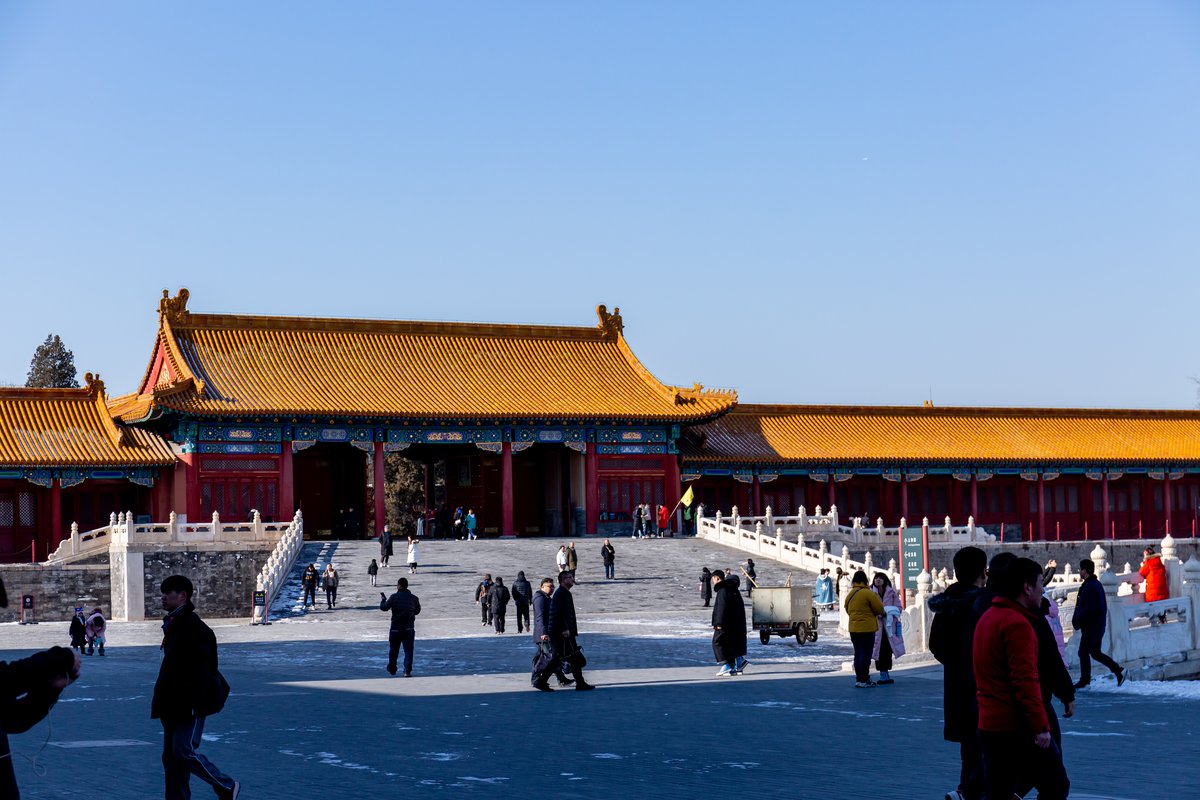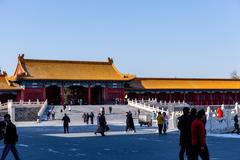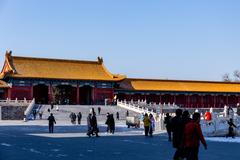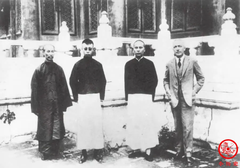
Forbidden City Visiting Hours, Tickets, and Historical Sites in Beijing
Date: 14/06/2025
Introduction
The Forbidden City (紫禁城, Zǐjìnchéng) is a monumental symbol of China’s imperial heritage and architectural mastery, standing in the heart of Beijing. As the largest and best-preserved ancient wooden structure complex in the world, it offers visitors an unparalleled window into China’s history, culture, and art. This guide provides detailed, up-to-date information about the Forbidden City’s visiting hours, ticketing procedures, accessibility, and essential travel tips, along with a thorough exploration of its historical and cultural significance.
Table of Contents
- Introduction
- Historical Overview
- Cultural and Architectural Significance
- Visitor Information
- Planning Your Visit
- Frequently Asked Questions (FAQ)
- Conclusion and Call to Action
- References and Further Reading
Historical Overview
Origins and Construction
Commissioned by the Yongle Emperor in 1406, the Forbidden City was constructed over 14 years by more than a million workers. It was designed to embody Chinese cosmology and imperial power, with a strict north-south axis, imposing walls, and a protective moat. The complex’s layout, symmetry, and architectural elements were carefully planned to reflect Confucian hierarchy and the emperor’s status as the “Son of Heaven” (History Skills; Travel to East).
Dynastic Seat of Power: Ming and Qing Eras
From 1420 to 1912, the Forbidden City served as the home of 24 emperors from the Ming and Qing dynasties. It was the epicenter of Chinese political and ceremonial life, hosting imperial audiences, state rituals, and daily court affairs. The architecture and spatial organization reinforced imperial authority, with grand halls for official functions and secluded quarters for the royal family (Asia Odyssey Travel; Monuments & Sights).
Transition to the Palace Museum
Following the fall of the Qing dynasty in 1912, the Forbidden City was transformed into the Palace Museum in 1925. Despite facing threats from war and natural decay, it has undergone significant preservation efforts and remains a UNESCO World Heritage Site, recognized for its universal value and cultural significance (Monuments & Sights).
Symbolism and Cultural Significance
The Forbidden City’s design reflects traditional Chinese philosophy, cosmology, and political ideology. Its status as a world-renowned museum and cultural symbol continues to inspire pride and curiosity both within China and internationally (China Discovery; Travel China Guide).
Cultural and Architectural Significance
Symbolism and Layout
The Forbidden City spans nearly 1,110,000 square meters with 980 surviving buildings and nearly 9,000 rooms (matadornetwork.com). It is meticulously organized along a central axis, with the Meridian Gate (Wumen) as the main entrance to the south and the Gate of Divine Prowess (Shenwumen) as the northern exit (beijingwalking.com). The complex is enclosed by a 10-meter-high wall and a 52-meter-wide moat, symbolizing exclusivity and imperial authority.
Key Structures and Features
- Hall of Supreme Harmony (Taihe Dian): The largest structure, used for major ceremonies such as coronations and imperial birthdays.
- Hall of Central Harmony (Zhonghe Dian) and Hall of Preserving Harmony (Baohe Dian): Used for rehearsals and smaller events, embodying ideals of balance.
- Palace of Heavenly Purity (Qianqing Gong): The main residence of the emperor.
- Imperial Garden (Yuhuayuan): A classical Chinese garden for imperial leisure (Gran Viaje China; Tour Beijing).
- Treasure Gallery and Clock Gallery: Feature rare imperial artifacts and require separate tickets.
Architectural highlights include golden glazed roofs, intricate wooden frameworks (dougong), red walls, and decorative animal statuettes, all serving symbolic and functional purposes (Travel to East).
Visitor Information
Visiting Hours
- April 1 – October 31: 8:30 AM – 5:00 PM (last entry at 4:00 PM)
- November 1 – March 31: 8:30 AM – 4:30 PM (last entry at 3:30 PM)
- Closed on Mondays (except public holidays)
(travelchinaguide.com)
Tickets and Booking
-
Advance Booking Required: All tickets must be booked online in advance; on-site sales are not available.
-
Booking Window: Tickets are released up to 7 days before your visit.
-
Passport Requirement: Foreign visitors must use their passport for booking and entry.
-
Prices:
- High Season (April–October): 60 CNY
- Low Season (November–March): 40 CNY
- Treasure Gallery and Clock Gallery: 10 CNY each
(chinadiscovery.com)
-
Booking Tips:
- Book as early as possible, especially for weekends and holidays.
- Morning sessions are less crowded and cooler.
- Each passport can only be used for one ticket per day.
Accessibility
- Wheelchair Access: Main routes are wheelchair accessible; ramps and elevators are available at key locations.
- Facilities: Accessible restrooms, nursery rooms, and stroller rentals are provided.
- Luggage Storage: Free at the Meridian Gate; retrieval at the north or east gates.
Getting There
-
Subway: Line 1 to Tian’anmen East or Tian’anmen West stations (both within a 10-minute walk to the Meridian Gate).
-
Bus: Multiple city routes stop near Tiananmen Square.
-
By Taxi: Taxis are available from the airport and major train stations.
(forbiddencitytravel.com) -
From Airports/Rail Stations:
- PEK Airport: Airport Express + Line 10 + Line 1 (~75 min)
- PKX Airport: Daxing Airport Line + Line 10 + Line 1 (~90 min)
- Beijing Railway Station: Line 2 + Line 1 (~30 min)
- Beijing West Railway Station: Line 9 + Line 1 (~50 min)
English signage and ticket machines are available throughout the subway system. Metro cards, tokens, and QR code payments are accepted. Avoid rush hours for a more comfortable journey.
Facilities and Services
- Audio Guides: Available in multiple languages at the entrance.
- Guided Tours: Bookable online or onsite.
- Restrooms: Well-marked and maintained throughout the complex.
- Shops and Cafés: Several souvenir shops and cafés inside the complex and near the gates.
- Stamp Collection: Collect commemorative stamps at designated spots for a unique souvenir (beijingdeeptour.com).
Planning Your Visit
Suggested Routes
- Central Axis Route (3–4 hours):
Meridian Gate → Hall of Supreme Harmony → Hall of Central Harmony → Hall of Preserving Harmony → Palace of Heavenly Purity → Imperial Garden → Gate of Divine Prowess. - Side Palaces and Galleries:
Explore the West and East Six Palaces, Treasure Gallery, and Clock Gallery for a deeper dive into imperial life. - Express Route (2 hours):
Focus on the main halls and garden for a concise yet enriching experience.
Practical Tips
- Dress Comfortably: Expect extensive walking; wear comfortable shoes.
- Weather: Summer is hot and exposed; bring sun protection. Winters can be cold—dress warmly.
- Security: Airport-style checks at entrances. Large bags are not permitted; use storage facilities.
- Photography: Allowed outdoors, but flash and tripods are prohibited inside most halls.
- Payment: Mobile payment (Alipay, WeChat Pay) is widely accepted. Cash is accepted at some points.
- Connectivity: Free Wi-Fi is available near entrances.
Nearby Attractions
- Jingshan Park: Just north of the Forbidden City, offering panoramic views of the palace and Beijing.
- Tiananmen Square: South of the Meridian Gate, a symbol of modern China.
- Wangfujing Shopping Street: Popular commercial area within walking distance.
Frequently Asked Questions (FAQ)
Q: Do I need to book tickets in advance?
A: Yes, all tickets must be booked online before your visit.
Q: What identification is required for entry?
A: The original passport used for booking.
Q: Are guided tours available?
A: Yes, both audio guides and English-speaking guides are available.
Q: Is the Forbidden City wheelchair accessible?
A: Main routes are accessible, but some side halls may have steps.
Q: Can I bring food and drinks?
A: Outside food is not allowed; water bottles are permitted. Cafés are located inside and near the gates.
Q: How long should I plan for my visit?
A: Most visitors spend 3–4 hours, but a focused 2-hour visit covers the highlights.
Conclusion and Call to Action
The Forbidden City is an extraordinary testament to China’s imperial legacy, architectural brilliance, and cultural symbolism. By planning ahead—booking tickets online, understanding visiting hours, and preparing for accessibility—you can fully appreciate this UNESCO World Heritage site. Enhance your experience with guided tours, stamp collections, and panoramic views from Jingshan Park. For seamless planning, download the Audiala app and stay updated on Beijing’s top historical attractions.
References and Further Reading
- History Skills
- Travel to East
- Asia Odyssey Travel
- Monuments & Sights
- China Discovery (Travel Tips)
- Travel China Guide
- Gran Viaje China
- China Discovery (Ticket Booking)
- Travel China Guide (Opening Hours)
- matadornetwork.com
- beijingwalking.com
- forbiddencitytravel.com
- beijingdeeptour.com
- Tour Beijing
















































